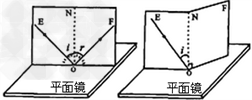问题
实验题
在“探究光反射的规律”时,让一束光EO贴着纸板射到平面镜上,在纸板上会看到反射光线OF.将纸板NOF沿ON向后折,此时在NOF面上看不到反射光线,如图乙所示,此实验说明_____________________________________.在图甲中,如果让光线逆着OF的方向射向镜面,会看到反射光线沿着OE方向射出,这表明_____________________________
甲 乙
乙
 乙
乙
答案
反射光线、入射光线和法线都在同一平面内;在反射现象中,光路是可逆的
